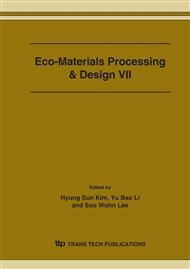p.906
p.910
p.914
p.918
p.922
p.926
p.930
p.934
p.938
Use of Bauxite Minerals to Control Pollutant Outflow in Urban Areas
Abstract:
Enormous use of ground for various purposes in urban areas has led to disappearance of green-planted surfaces. Considering space constraints, planted roofs become one promising and stabilizing choice to improve amenity and reduce the thermal loads on the building’s shell. However, a critical issue for rooftop garden is the release of pollutants in urban runoff. Not only particles but also dissolved pollutants should be removed from building drainage because of their potential impact on water environment. To add functions for the control of pollutant outflow, bauxsite minerals made of red waste from alumina refineries were incorporated in the rooftop garden as a special soil. The minerals have high trapping capacities for trace metals and other soluble species. Moreover, they are easy to integrate with rooftop garden systems. Based on their equilibrium capacity for removing pollutants, an optimum amount of bauxsite minerals is suggested. The characteristics of rainwater runoff and pollutants release were compared for normal and modified rooftop garden in laboratory scale. As expected, the green roof system with the bauxsite layer reduces the concentration of heavy metals. The technique used in this study is also likely to be implemented in other green surfaces in housing complexes.
Info:
Periodical:
Pages:
922-925
Citation:
Online since:
March 2006
Authors:
Keywords:
Price:
Сopyright:
© 2006 Trans Tech Publications Ltd. All Rights Reserved
Share:
Citation:


